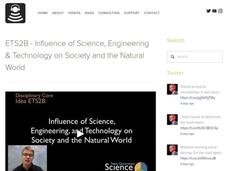Hyperbole Teacher Resources
Find Hyperbole lesson plans and worksheets
Showing 531 resources
Bozeman Science
LS4C - Adaptation
Learn how the study of adaptation progresses through grade levels. The narrator provides a curricular view of teaching adaptation complete with examples. Concepts range from simple trait adaptations to speciation and natural selection.
Bozeman Science
ETS2B - Influence of Science, Engineering and Technology on Society and the Natural World
Science, engineering, and technology have an impact on our natural world. As the world population increases, the demands on natural resources also increase. Science, technology, and engineering work together to address these concerns...
Bozeman Science
ETS1A - Defining and Delimiting an Engineering Problem
Explore the meaning of an engineering problem-solving process. By defining specific world problems, the narrator emphasizes the importance of engineering in our world. He outlines the engineering process and connects the information to a...
Bozeman Science
ESS1C - The History of Planet Earth
Take a trip back in time as the history of the earth is uncovered. An interesting video lesson explains the different methods scientists use to learn about the earth's past. While emphasizing teaching strategies, the lesson instructor...
Bozeman Science
ESS1B - Earth and the Solar System
The motion of the earth around the sun creates many different patterns in our world. Watch as a video instructor explains the patterns of moon phases, sunrise and sunset times, seasons, tides, and constellations among others. He also...
Bozeman Science
ESS1A - The Universe and Its Stars
Is there a broader topic than the study of the universe? A video lesson for teachers provides insight into the progression of lessons on the topic from elementary through high school. Examples and descriptions give teachers solid...
Bozeman Science
ESS2D - Weather and Climate
Where does our weather come from? A thorough video lesson discusses the NGSS standard ESS2D instruction from elementary through high school. The instructor explains the factors the impact weather and climate and the long-term effects of...
Bozeman Science
ESS3A - Natural Resources
Explore the natural resources on earth in relation to the specific Next Generation Standard. Understanding these resources are not evenly distributed in all locations helps gain a perspective of their uses. Nonrenewable...
Bozeman Science
ESS3B - Natural Hazards
Planning and preparing for natural disasters is possible and necessary. A video lesson begins with a description of natural hazards in relation to natural disasters. Using specific examples, the instructor shares strategies for preparing...
Bozeman Science
ESS3C - Human Impacts on Earth Systems
The human impact on the earth's systems often has unintended consequences. A comprehensive video lesson builds a progression for teaching the standards ESS3C in elementary through secondary classrooms. Instruction focuses on the...
Pittford Schools
Literary Devices, Techniques, and Elements
What's the difference between a speaker and an author? What's an example of anthropomorphism? Clarify the meanings of literary devices, elements, and techniques with a comprehensive glossary of terms.
Bozeman Science
Anaerobic Respiration
Just when you thought you had a good grasp of aerobic respiration, in the presence of oxygen, you learn that respiration can occur without oxygen. What?! In the video, learners see how organisms, in the absence of oxygen, can survive...
Bozeman Science
Nervous System
The average adult human brain contains 100 billion neurons. In the video, scholars learn about brain lateralization and how different portions of our brain do different things. Learners then explore neurons, learning their parts and how...
Curated OER
Identify Figurative Language
Your class can identify idioms, metaphosr, similes, hyperboles or personification by reading poetry and interpret meaning.
Curated OER
Magic Squares: The Awakening
After matching words drawn from Kate Chopin’s novel, The Awakening, with their definitions, readers complete a magic square game. Included are instructions for how to develop magic squares.
Shmoop
ELA.CCSS.ELA-Literacy.L.11-12.5
"Timid, scared, terrified." High school scholars examine words, their denotations and connotations, in a series of exercises that use lines from Shakespeare to explore figurative language and word relationships. Participants then...
Curated OER
Matter and Heat
Students examine how heating causes substances to expand, and cooling cause it to contract. They investigate the states of matter.
Curated OER
Expressing Our Thoughts Through Poetry
Students create a poem on about spring. They read final version of their poem chorally. They write reflections of their experience in creating the poem.
Curated OER
Review of Literary Devices
Sixth graders review literary devices. They use both fiction and nonfiction texts to review metaphor, simile, alliteration, imagery, symbolism and personification. This lesson plan has a scripted guide for the teacher to follow.
Curated OER
Metaphor
High schoolers identify the distinction between literal and figurative language with a focus on metaphors. They complete a metaphor analysis chart, then practice expanding metaphors by composing their own comparisons of elements of the...
Curated OER
Review of Personification and Alliteration
Students review personification and alliteration. In this literary devices instructional activity, students use personification and alliteration in a sentence. Students draw a picture reflecting personification.
Curated OER
Humor, Rhetoric, and Prose Styles
A handful of quotes are presented in these slides referencing writing and rewriting. Learners will be encouraged by well-known writers to practice, grow and refrain from perfectionism. Quotes also reference how to write for your audience...
Curated OER
Literary Terms for Sophomore English Vocabulary Assessment
Sophomores record the definitions and examples of a series of literary terms and then create their own example of the word. Designed as an assessment, the presentation could also be used as an introduction or as a review.
Curated OER
Poetry: Basic Elements of a Poem
People who pen poetry positively need to know basic tenets and terms of poetry, like alliteration and consonance, for example. These and other terms are define and illustrated. Then viewers are given an object and asked to craft a...
Other popular searches
- Hyperbole Examples
- Hyperbole Worksheets
- And Hyperbole
- Hyperboles
- Hyperbole or Exaggeration
- Hyperbole Elementary
- Poetry and Hyperbole
- Hyperbole in Poetry
- Writing Using Hyperbole
- Hyperbole Worksheet 6th
- Idioms and Hyperbole
- Hyperbole Examples Pictures

























